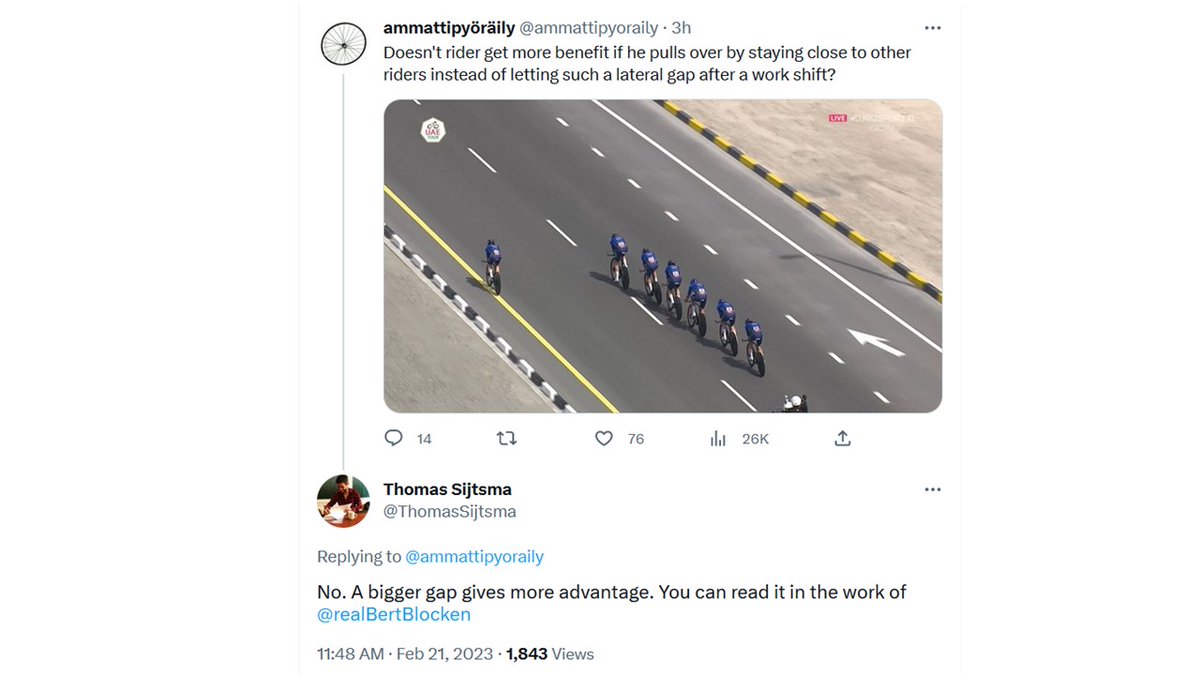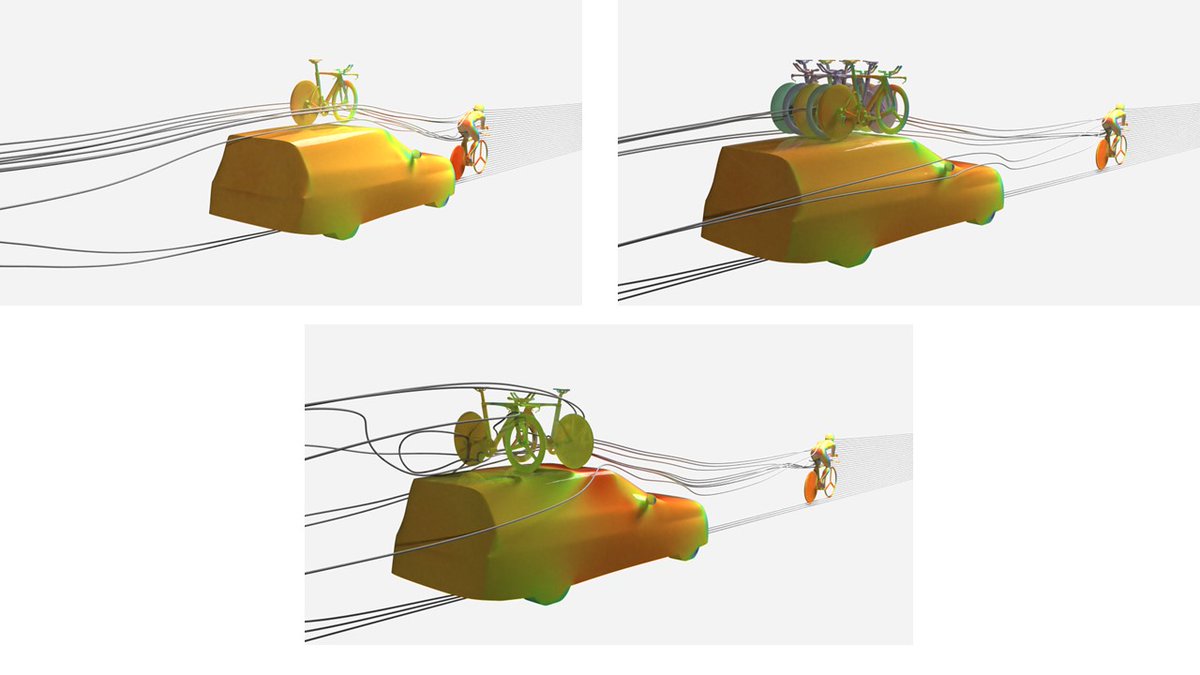(0/n) Tomorrow, #Belgian #cycling season starts again with opening classic @OmloopHNB @Nieuwsblad_be Upon several requests, we provide thread on our research in cycling #aerodynamics including practical ramifications. Work by @KU_Leuven et al. in partnership with @Ansys
#Science
#Science

(1/n) Well-known: cyclist in slipstream of another cyclist can typically get aerodynamic drag reduction of 30-40%. Is much more behind motorcycle, car or train. Known since at least 1899. “#Drafting” in the #slipstream is therefore common practice.
#Science #Engineering #cycling
#Science #Engineering #cycling

(2/n) This is because air as medium gives pressure field so 1st rider literally gets “push” by 2nd. We published this in 2013. First lot of criticism & disbelief, now many say “we know this all along”. Yeah right 😊. That’s how it always goes… urbanphysics.net/2013_CAF_BB_TD…
#Cycling
#Cycling

(3/n) The larger the cyclist or vehicle behind you, the larger the “push”. So team car in ITT behind cyclist can give big aero benefit. In 2015, we showed that 1, 3, 5, 10 m distance gives drag reductions of 13.5, 3.7, 1.4, 0.2%. urbanphysics.net/2015_JWEIA__BB…
@KU_Leuven #cycling #cfd
@KU_Leuven #cycling #cfd
(4/n) @UCI_cycling rule for minimum distance of team cars behind cyclist in ITTs was 10 m. This number makes no sense. Not enough to avoid aero benefit. And no car this size can stop/break in 10 m at 50 km/h, even on dry road…
#cycling #aerodynamics #engineering #science #cfd
#cycling #aerodynamics #engineering #science #cfd

(5/n) In 2017 article in leading newspaper @lequipe , Dr. @fredgrappe –very intelligent Head of Performance @GroupamaFDJ – confirmed our #research. However, Tech Director of UCI (no names here out of courtesy) called our work “nonsense”, declared UCI would not act upon it... 

(6/n) Luckily @UCI_cycling has recruited better people since. New UCI rule incited by former top cyclist @mickrogers based on our work changed 10 to 25 m. UCI press release: uci.org/pressrelease/u…
(7/n) VERY good rule change for fairer & safer racing. So thank you @UCI_cycling & thank you Michael Rogers (@mickrogers) for excellent work.
(8/n) But only effective WHEN (!) strictly enforced. Because sometimes in the past, distance was 1 m, sometimes 2, 3... But often not the minimum of 10… Rules without enforcement are useless.
#cycling #aerodynamics #omloop @OmloopHNB
#cycling #aerodynamics #omloop @OmloopHNB
(9/n) If you want the car at 10 m or less to give more aero advantage, do not use aerodynamic sports car (sorry Jaguar & former Team Sky) but use a non-aerodynamic vehicle, a mini van or a truck or…
#cycling #aerodynamics @OmloopHNB @KU_Leuven
#cycling #aerodynamics @OmloopHNB @KU_Leuven

(10/n) … put a lot of bicycles on the roof of your team car, which decreases the aerodynamics of the car and increases the “push” effect on the cyclist. Can decide who wins or loses the race. 

(11/n) Also motorcycle behind cyclist gives aero advantage. 0.25, 0.5, 1, 5 m distance gives drag reductions of about 8.7, 6.4, 3.8, 1.4%. See 1 m distance in first part of this movie.
sciencedirect.com/science/articl…
sciencedirect.com/science/articl…
(12/n) Motorcycle riding next to cyclist increases drag – a lot. Sponsors might be happy to be on tv, but cyclist should be unhappy & keep lateral distance. Many seconds can be lost riding side-by-side, e.g. 2.16 s per km in time trial speed. link.springer.com/article/10.100…
@KU_Leuven
@KU_Leuven

(13/n) Cyclists riding side-by-side increase each other’s air resistance, up to 8%. If you are riding with friends and in the end want to exhaust yourselves, go ahead and ride alongside. Otherwise: behind each other. Then both benefit (!). 

(14/n) Therefore, in TTTs, leading cyclist should drop off keeping large lateral distance. Looks funny, is smart. We introduced this @JumboVismaRoad 9 yrs ago with @m_heijboer, very intelligent Head of Perform., who understood/trusted us. First criticised, now more teams adopt it 

(15/n) Riding behind motorcycle gives huge benefit. Fact was known, numbers of drag reduction/time gains were not. We studied it in this paper: link.springer.com/article/10.100…. Time gains at 10, 30, 50 m are 5.4, 2.7 and 1.6 s per km at 54 km/h.
(16/n) Riding behind car also gives huge benefit. Fact was known, numbers were not. Studied in tbis paper: urbanphysics.net/JWEIA_Cyclist_…. Drag reductions at 10 and 40 m are about 20 and 7%, respectively. 

(17/n) In tightly packed full cycling peloton, every rider benefits. First rider has only 80-90% of drag of cyclist riding alone.
@KU_Leuven @ANSYS @HPE
@KU_Leuven @ANSYS @HPE
(18/n) While in belly of #peloton, aerodynamic drag goes down to 5-10% of cyclist riding alone. But: that also means that relatively speaking, other resistances become larger. So total resistance will be 10-20% of cyclist riding alone.
#cycling #aerodynamics #cfd #windtunnel
#cycling #aerodynamics #cfd #windtunnel

(19/n) And evidently, going through bends when the peloton stretches, these numbers become much larger. Still, they indicate how praiseworthy successful escape attempts are. 

(20/n) In cycling, as in some other parts of life, the statement holds: “gravity is a bitch” (apologies for my language). At pro speed & as soon as the inclination is above about 1.5%, gravity takes over as most important resistance. Does not mean aero is unimportant (!)
(21/n) Here study on the importance of drafting, even when climbing. Aero can still be 10% of total resistance. Not negligible. Statements that aero is not important in climbing is old school nonsense, sorry. Most teams know already long-time, see photo
link.springer.com/article/10.100…
link.springer.com/article/10.100…

(22/n) We thank all who contributed to the aforementioned research efforts and results. Special gratitude to our friends at @UniversiteLiege & @ANSYS for many years of great support/collaboration. Special thanks to @JumboVismaRoad & @GroupamaFDJ for confiding in us.
@KU_leuven
@KU_leuven
(23/n) Enjoy the cycling season, respect the riders – when on and off the bike – and stay safe.
• • •
Missing some Tweet in this thread? You can try to
force a refresh







